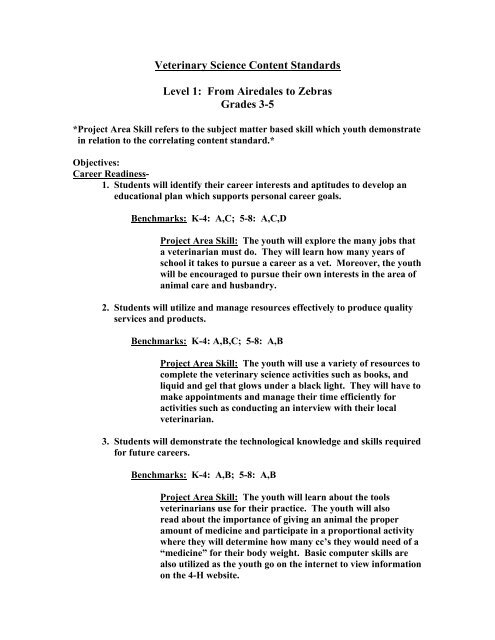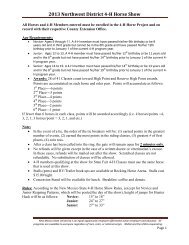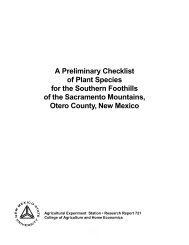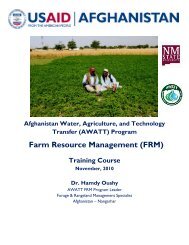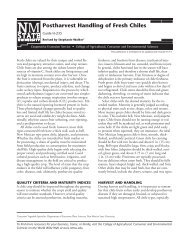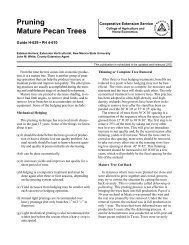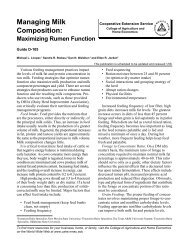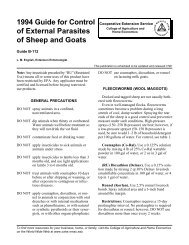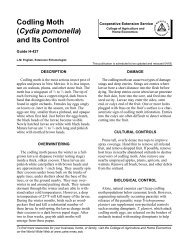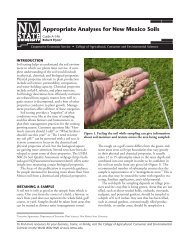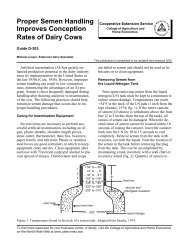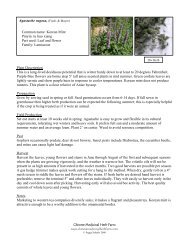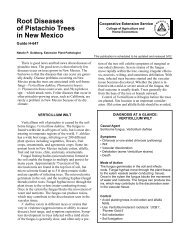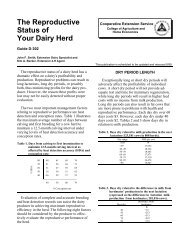From Airedales to Zebras
From Airedales to Zebras
From Airedales to Zebras
- No tags were found...
Create successful ePaper yourself
Turn your PDF publications into a flip-book with our unique Google optimized e-Paper software.
Veterinary Science Content StandardsLevel 1: <strong>From</strong> <strong>Airedales</strong> <strong>to</strong> <strong>Zebras</strong>Grades 3-5*Project Area Skill refers <strong>to</strong> the subject matter based skill which youth demonstratein relation <strong>to</strong> the correlating content standard.*Objectives:Career Readiness-1. Students will identify their career interests and aptitudes <strong>to</strong> develop aneducational plan which supports personal career goals.Benchmarks: K-4: A,C; 5-8: A,C,DProject Area Skill: The youth will explore the many jobs thata veterinarian must do. They will learn how many years ofschool it takes <strong>to</strong> pursue a career as a vet. Moreover, the youthwill be encouraged <strong>to</strong> pursue their own interests in the area ofanimal care and husbandry.2. Students will utilize and manage resources effectively <strong>to</strong> produce qualityservices and products.Benchmarks: K-4: A,B,C; 5-8: A,BProject Area Skill: The youth will use a variety of resources <strong>to</strong>complete the veterinary science activities such as books, andliquid and gel that glows under a black light. They will have <strong>to</strong>make appointments and manage their time efficiently foractivities such as conducting an interview with their localveterinarian.3. Students will demonstrate the technological knowledge and skills requiredfor future careers.Benchmarks: K-4: A,B; 5-8: A,BProject Area Skill: The youth will learn about the <strong>to</strong>olsveterinarians use for their practice. The youth will alsoread about the importance of giving an animal the properamount of medicine and participate in a proportional activitywhere they will determine how many cc’s they would need of a“medicine” for their body weight. Basic computer skills arealso utilized as the youth go on the internet <strong>to</strong> view informationon the 4-H website.
4. Students will develop and demonstrate responsible and ethical workplacebehaviors.Benchmarks: K-4: B,C,E; 5-8: A,B,CProject Area Skill: The youth will look at safety in regards <strong>to</strong>pet care. They will look at a variety of scenarios, anddetermine the pet safety concerns in their own home.Moreover, the youth will demonstrate appropriate behavior asthey work <strong>to</strong> accomplish the tasks set forth by the activity.5. Students will develop effective leadership, interpersonal, and team skills.Benchmarks: K-4: B,C; 5-8: CProject Area Skill: The youth will work with othersin certain activities such as using a gel and shaking hands witha buddy <strong>to</strong> see how easily germs can be transferred. The youthare also encouraged <strong>to</strong> participate in a discussion aftercompletion of each activity with their peers or group helper.
Veterinary Science Content StandardsLevel 1: <strong>From</strong> <strong>Airedales</strong> <strong>to</strong> <strong>Zebras</strong>Grades 3-5*Project Area Skill refers <strong>to</strong> the subject matter based skill which youth demonstratein relation <strong>to</strong> the correlating content standard.*Objectives:Health Education-1. Students will comprehend concepts related <strong>to</strong> health promotion anddisease prevention.Benchmarks: K-4: A,G; 5-8: A,D,F,IProject Area Skill: Using a special gel, the youth will explorehow easily germs can be spread, even through a simplehandshake. They will learn the importance of washing theirhands and how some environments may contain more germsthan others.3. Students will demonstrate the ability <strong>to</strong> practice health enhancingbehaviors and reduce health risks.Benchmarks: K-4: A,C,F; 5-8: FProject Area Skill: The youth will look at safe relationshipsas they relate <strong>to</strong> having pets in their home. They will look at avariety of pic<strong>to</strong>rial scenarios and determine which situationsare dangerous for pets. They will then write down somepotentially dangerous areas for pets in their own homes.
Veterinary Science Content StandardsLevel 1: <strong>From</strong> <strong>Airedales</strong> <strong>to</strong> <strong>Zebras</strong>Grades 3-5*Project Area Skill refers <strong>to</strong> the subject matter based skill which youth demonstratein relation <strong>to</strong> the correlating content standard.*Objectives:Language Arts-1. Reading and Listening for Comprehension: students will apply strategiesand skills <strong>to</strong> comprehend information that is read, heard, and viewed.Benchmarks: K-4: A,B,C,D; 5-8: A,B,C,DProject Area Skill: The youth will read information and applyit while participating in activities in veterinary science. Theywill learn and utilize new vocabulary as it pertains <strong>to</strong> the vetindustry and moni<strong>to</strong>r their comprehension of each activity byanswering questions listed at the end of each activity.2. Writing and Speaking for Expression: students will communicateeffectively through speaking and writing.Benchmarks: K-4: A; 5-8: CProject Area Skill: The youth will communicate their findingsin the activity by writing down answers <strong>to</strong> comprehensivequestions listed at the end of each activity. The youth willutilize communication skills by interviewing a localveterinarian using questions they formulated from the text inthe workbook.3. Literature and Media: students will use literature and media <strong>to</strong> developan understanding of people, societies and self.Benchmarks: K-4: A; 5-8: AProject Area Skill: The youth will read a book or watch amovie about a veterinarian. They will write down the keypoints of the book or movie they have observed, identify themain animal and person and determine the relationshipbetween them.
Veterinary Science Content StandardsLevel 1: <strong>From</strong> <strong>Airedales</strong> <strong>to</strong> <strong>Zebras</strong>Grades 3-5*Project Area Skill refers <strong>to</strong> the subject matter based skill which youth demonstratein relation <strong>to</strong> the correlating content standard.*Objectives:Math-1. Measurement: students will understand measurement systems andapplications.Benchmarks: K-4: A,B; 5-8: A,BProject Area Skill: The youth will learn the importance ofmeasurement for the field of animal science. They willparticipate in an activity which they will determine how muchmedicine the youth would receive depending on their bodyweight. To perform this task they must measure weight andvolume.2. Data Analysis and Probability: students will understand how <strong>to</strong>formulate questions, analyze data, and determine probabilities.Benchmarks: K-4: A,B,C; 5-8: AProject Area Skill: The youth will record data in chartsprovided by the activity book. They will fill in the charts withinformation gained from asking veterinarians questions,identifying breeds and habits of animals and the nutrition ofcertain animal feeds. They will analyze the data <strong>to</strong> answercomprehensive questions listed at the end of the activity andparticipate in discussions with their peers and group leaders.
Veterinary Science Content StandardsLevel 1: <strong>From</strong> <strong>Airedales</strong> <strong>to</strong> <strong>Zebras</strong>Grades 3-5*Project Area Skill refers <strong>to</strong> the subject matter based skill which youth demonstratein relation <strong>to</strong> the correlating content standard.*Objectives:Science-Strand I: Scientific Thinking and PracticeStandard I: Understand the processes of scientific investigations and use inquiryand scientific ways of observing, experimenting, predicting, and validating <strong>to</strong> thinkcritically.K-4 Benchmarks: I,IIProject Area Skill: The youth will record data in charts provided forthem by the veterinary science activity book. They will analyze thedata <strong>to</strong> form conclusions and record their findings by answeringquestions listed at the end of each activity. Moreover the youth willunderstand the importance of the scientific method as it applies <strong>to</strong>veterinary science.Strand III: Science and SocietyStandard I: Understand how scientific discoveries, inventions, practices, andknowledge influences, and are influenced by, individuals and societies.K-4 Benchmarks: IProject Area Skill: The youth will learn how germs can betransmitted through human interaction such as shaking hands. Theywill learn how easily germs can be spread and the importance ofkeeping clean. Moreover the youth will learn how washing theirhands can be one way of helping <strong>to</strong> s<strong>to</strong>p the spread of disease.


